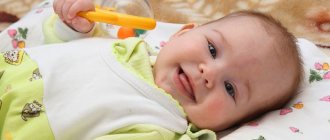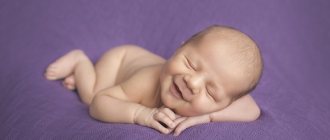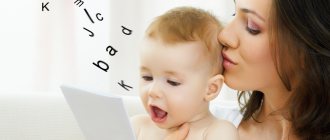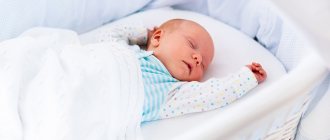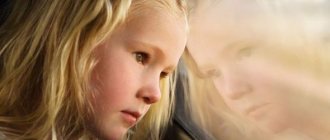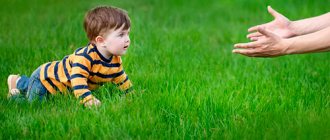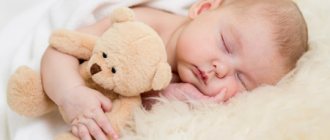What does a baby learn from 0 to 1 month?
The first month of a newborn's life is considered a period of adaptation. During these 30 days, the new member of your family must have time to do a huge amount of work to rebuild his body: for most of his life he existed in an aquatic environment, where he was provided with heat, nutrients and oxygen, and now he needs to breathe on his own, regulate the heat exchange system himself, extract milk from mother's breast.
This requires enormous energy expenditure, so in the first month the baby sleeps and eats most of the time. In the first weeks of life, sleep is very important for a baby: during sleep, he grows, and the body gets used to the new environment. The duration of wakefulness during the day in the first month usually does not exceed 2–4 hours. Breastfeeding quickly improves: a newborn eats on average every 2 hours, at night 3-5 times (don’t forget - everything is very individual). Your baby will set his own sleep, feeding and wakefulness schedule depending on his physiological characteristics and temperament. Your task as parents is only to notice and maintain these rhythms, learning to recognize and satisfy the child’s needs.
Physical and psycho-emotional development during this period occurs by itself, almost imperceptibly, but continuously. Despite the fact that the baby does not yet demonstrate any special achievements, he absorbs a lot.
You can keep a diary where you will record all your baby’s achievements: he smiled for the first time, started crawling, took his first steps. This will help to track the dynamics of development and preserve pleasant memories for life.
Physical development:
- Movements of arms and legs are chaotic;
- Hypertonicity of the arms and legs remains, the fists are tightly clenched;
- Raises his head while lying on his stomach;
- Learns to fix the gaze on a stationary object;
- Innate reflexes are still highly developed, thanks to which the baby adapts to the environment - sucking, searching (searching for the mother's breast), grasping (squeezing everything that falls into his fist), walking reflex (moves his legs, as if walking, if you hold it in an upright position on a hard surface), swimming, Mohr's reflex (brings the arms and legs together and apart, reacting to a loud and sudden sound), etc. As the child develops, they will gradually fade away, leaving room for the basic reflexes of an adult (blinking, sneezing, yawning , flinching, etc.).
Psycho-emotional development:
- Can please you with your first smile (the so-called physiological smile);
- Makes the first sounds (sniffles, groans), and if they talk to the child a lot, pleases the parents with cooing (humming);
- Reacts by flinching, freezing, or crying to sudden and loud sounds;
- Stops crying when picked up;
- Actively helps during feeding (makes himself more comfortable, looks for and catches the nipple of his mother's breast in his mouth).
Now your baby needs especially close physical and visual contact with his mother and her response to his needs, which lays a solid foundation for the child’s psychological well-being. During this difficult time, the family’s strength and cohesion are tested: so that the mother can devote herself to the newborn, let other family members take on all the other concerns about the house.
Newborn hearing
But the baby begins to hear in the womb. He can perceive melodies and voices by ear. Especially often he hears his mother’s voice. Therefore, when born, she is one of the first to recognize him.
As soon as they are born, newborns begin to hear predominantly sharp, loud and high-pitched sounds as significant stimuli. Babies have the appropriate reaction to them: flinching, fear, crying, freezing. Monotonous or blurry sounds (human conversation, a working TV or a hairdryer in the next room) still remain a familiar background. The child will begin to respond to them closer to 3–4 months. Therefore, you should not worry that your baby’s hearing is impaired if he shows a reaction to loud and sharp sounds. But if it is not there, you need to visit a pediatrician.
In the first 2 months of a child’s life, try to protect his delicate psyche from sharp, sudden sounds and screams (even a strong cough or sneeze can scare the baby).
However, already in the first month, babies react not only to loud sounds or rattles, but also to the intonation of an adult’s speech, his timbre of voice. Absolutely all children love listening to music (especially classical).
Outwardly this manifests itself in different ways:
- active movements of the limbs;
- turning the head towards the sound;
- flinching or freezing;
- crying or listening.
The baby may also frown or start blinking.
From the second month, the reaction to changes in the rhythm of sounds will be obvious: if the mother speaks faster, the baby’s arms and legs begin to move in time with her speech rate, and vice versa. If she starts talking in a rough voice, the baby may frown or freeze.
With each month, the child shows reactions to increasingly quieter and more distant sounds. During this period, his intellect also actively develops, the baby becomes interested in what is happening around him. After about six months, we can say that the child’s hearing has leveled out. Now he even listens to rustles and whispers in another room.
This is how the organs of vision and hearing develop in newborns. Bright and musical toys and objects, as well as mother’s singing, can help the baby with this.
The condition of the baby immediately after birth raises a number of questions and concerns among young parents. Why does he react poorly to noises - for example, does he not wake up when a vacuum cleaner is running in the next room? Why doesn't he notice when someone enters the room? And in general, is everything okay and when do newborns begin to see and hear? In fact, as a rule, there is no real cause for concern, and now we will find out why.
In the mother's belly it is comfortable, warm and dark, and suddenly the baby finds himself in a new world, full of movement, light, colors, sounds. Nature is very wise: it protects a newly born person from stress associated with a sudden “change of environment.” The development of all functions (vision, hearing, motor activity) should occur naturally over several months. And how correctly this happens, in some cases only an experienced doctor can say.
How does a baby develop by 2 months?
At this age, the baby sleeps noticeably less: periods of prolonged daytime wakefulness appear. Daytime sleep is shortened. A nighttime sleep pattern is being developed: now its duration is 10–12 hours with breaks for feeding, during which the baby may not wake up completely.
Physical development:
- Lying on your stomach, hold your head at an angle of 45 degrees for some time;
- Rolls over from side to back;
- Holds the head in an upright position for 1 – 2 minutes;
- Follows moving objects with his eyes;
- Turns his head towards the sound;
- Hypertonicity of the hands disappears;
- Some reflexes of the newborn (grasping, walking reflex) fade away.
Psycho-emotional development:
- Demonstrates a “revival complex” - active movements of the arms and legs in response to the appearance of the mother, humming, a wide smile;
- Freezes, listening to sounds;
- Smiles in response to affectionate treatment, conversation, smile;
- Reacts to familiar voices;
- He hums and sings some sounds.
The development of perception of shape and color can be stimulated by hanging pictures with bright, clear shapes and patterns on the sides of the crib: black and white, red, yellow, blue, green, orange.
When does a newborn begin to see?
The baby reacts to light from birth, and he will defend himself from intense light - turn away, squint his eyes, cry angrily. But the visual acuity of a newborn baby is very low.
The increased refractive power of the lens causes physiological farsightedness in newborns. There is no focus for a week or two, but after about 10 days the baby is able to fix his gaze for a few seconds.
After about 2-3 weeks, the baby begins to respond to objects, to large black and white pictures. It is not clear how a child at 1 month sees other colors; he begins to react to colorful objects later, after a few weeks.
What can a baby do by 3 months?
Perhaps the main achievement of this month and joy for parents is the emergence of a routine that the baby builds together with his mother. There is already a distinct time of waking up, feeding and falling asleep with two or three (sometimes four times) daytime sleep.
At this age, the baby already knows how to express his dissatisfaction by screaming and crying and requires attention. Observant parents can notice the first manifestations of a child’s character.
Physical development:
- Holds his head confidently when lying on his stomach and in an upright position;
- When lying on his stomach, he rests on his forearms;
- Examines and sucks hands;
- Rolls from back to side;
- Tries to grab and hold the toy in his hand, and then pulls it into his mouth.
Psycho-emotional development:
- Maintains eye contact;
- Smiles and laughs;
- It can hum for a long time, the humming becomes varied;
- Recognizes the faces of loved ones;
- Fixes gaze on stationary objects for a long time (up to 5 minutes).
Arrange a family council and make a list of character traits of the baby's close relatives. Pay special attention to undesirable qualities. This is a good reason to start thinking about what methods of education could help correct them, and which ones will help develop those qualities that you dream of seeing in your heir.
Child and vision
One of the common questions asked by young mothers is: when does a newborn child begin to see? Of course, babies develop the ability to see immediately from the moment they are born. However, their vision has some features that make it easier to transition from the warm and dark mother’s tummy to our bright and colorful world. Newborn babies perceive surrounding objects completely differently from adults. How do newborns see? The objects around them seem to be in a fog . They clearly distinguish between bright and dark spots, that is, the baby can understand whether the room is dark or light. They also see bright large objects at close range.
If the mother wants the baby to see her, she needs to lean towards him at a distance of about 25 cm. This is the only way the child will be able to distinguish between a loved one and a loved one. Mom's face is the first object that the baby studies especially carefully, because he sees it up close quite often, every time during feeding. However, even on the dear mother’s face, the child cannot fully focus his gaze. They are not yet able to look at one point for a long time; the baby will receive this opportunity at about 4 months.
Newborns look at all the objects around them with a sliding gaze.
A shifting or unfocused gaze often frightens parents. Unable to concentrate on one subject, the child may slightly squint his eyes. This is a variant of the norm. This condition usually goes away completely within 5-6 months. If this feature persists for a longer period of time, the baby should be shown to a doctor to identify true strabismus. The sooner this happens, the greater the chance of correcting the unpleasant problem.
Stages of vision improvement
The ability to distinguish colors in children appears after 3 months. Before this period, the child clearly sees only black and white. If you decide to buy a mobile for your baby, you can equip it with toys of these two contrasting colors. Simple geometric shapes will do; the time for bear cubs and bunnies will come a little later. Important advice: do not hang toys too low above the crib, close to the baby’s face, to prevent the development of strabismus.
After the baby is 3 months old, he begins to distinguish the first colors - yellow and red. At this age, the child loves to look at carpets hanging nearby on the wall, or toys with large patterns. The baby's vision becomes full by about 6 months .
Baby development by 4 months
At 4 months, the main thing for a child is coordination of eye and hand movements. The grasping reflex gradually weakens, hand movements become conscious and take on meaning, especially when you need to reach something, the grasping reflex gradually fades away. It is your own hands (and sometimes even feet) that become the baby’s most favorite toys.
Active salivation may appear - this is how teeth begin to erupt. Don't be surprised if this happens only after a couple of months or more.
Physical development at 4 months:
- On his own or with the help of an adult holding him by one hand, he turns over from his back to his stomach (and sometimes from his stomach to his back);
- Reaches for objects, feels them;
- He licks his fingers, sucks his fist, and for the same purpose tries to reach the legs to his mouth;
- Rhythmically jerks its legs and transfers weight to them;
- Hypertonicity of the legs disappears.
Psycho-emotional development at 4 months:
- In communication he gives preference to his mother, recognizes her, rejoices when she appears, can be capricious when she leaves for a while;
- “Coos” with his parents when he is in a good mood;
- Actively smiles, laughs, squeals with delight;
- Reacts to the sound of his name;
- Can spend a long time occupied with toys hanging over the crib;
- Babbling appears and the first syllables are “ma”, “ba”, “pa”.
Changes in vision in newborns by month
The child’s visual system, as well as his entire body, gradually develops and strengthens. Let's consider what exactly and how babies see as they grow up.
| Age (months) | What does the baby see |
| 1 | The look becomes meaningful. The child is able to focus his gaze and follow a large object at a distance of no more than 60 cm. |
| 2 | He can look at an object that interests him for a long time and follows its movements. Recognizes mother and other family members. |
| 3 | A reaction to color appears, his attention is attracted by bright toys. Recognizes red and yellow colors. Turns its eyes following the movement of the toy. |
| 4 | May look at a toy he likes for a long time. Begins to distinguish blue, green, and then other shades. The formation of vision goes in parallel with the development of motor skills - the child tries to grasp what interests him |
| 5 | Stereoscopic vision is formed - the baby is able to navigate in space, fixate his gaze on a toy, estimate the distance to it and reach. He sees objects near and far, recognizes people and objects. Increased mobility also helps with this - the child rolls over, crawls, and tries to get up. The color range is expanding. |
The first year of life is the most critical and intensive time of formation of the visual system. To verify this, it is enough to compare how a child sees at 3 months, at 6 months and at one year. The vision of a one-year-old child already in many ways resembles the vision of an adult.
Physiological farsightedness remaining after childbirth finally disappears on average by the age of 3 years. But the complete formation of the visual system ends only by 6-7 years.
Developmental stages at 5 months
The fifth month passes under the motto “I want to move!” Let the baby continue to try to roll over, rock, and sit down, the main thing is to ensure his safety at these moments. If you notice that your baby needs more space than he has in his crib or playpen, you can lay him out on the floor. Prepare the surface for this in advance: it should be clean and pleasant for contact with the baby’s delicate skin; a soft mat is perfect for these purposes.
During this period, the sleep, wakefulness and feeding patterns may begin to change again. Sometimes the baby may not wake up all night, even for feeding, or get up very early and no longer get enough sleep in the morning.
Physical development at five months:
- Lies on his stomach for a long time, leaning on his outstretched arms, and may begin to crawl on his bellies;
- Confidently rolls over from back to stomach;
- Sits with support, while the back is strongly bent;
- Entertains himself by playing with his own arms and legs;
- Confidently grabs objects and holds them in his hands for a long time.
Psycho-emotional development at five months:
- Recognizes mother's voice;
- Distinguishes the faces of loved ones from strangers;
- Reacts differently to different tone of address - smiles in response to an affectionate tone of voice and frowns when there is a strict intonation;
- It hums long and melodiously;
- He himself encourages parents to communicate - he smiles, babbles, stretches his arms; gets capricious if there is not enough communication.
At this age, children often confuse day with night (this feature can appear earlier, but is more common between 4 and 6 months). Think about why: maybe your baby has too long naps, or he doesn't get enough exercise during the day, or the air in the room is too dry and warm.
How to improve a child's color perception?
Teachers and doctors advise communicating with a small child as often as possible, speaking out loud and explaining everything that is happening around, while naming the main colors.
It is advisable to give communication a playful form, to interest the baby as much as possible, but not to let him become overtired. With the correct, responsible and moderate approach of parents to the issue of development, the child begins to quickly learn not only to distinguish colors, but also to better understand the world. If parents notice that, despite regular activities with their child, he cannot recognize colors and their shades for a long time, this should be a reason to consult a doctor.
How does a baby develop at 6 months?
What would you like to eat? Yes, it is at six months that the baby begins to show interest in food. This is a new stage in its development, and not at all evidence of a lack of milk in the mother or malnutrition of the child. From 6 months you can introduce the first complementary foods.
Physical development:
- Sits down from a position on all fours;
- Rolls over from stomach to back and from back to stomach;
- Gets on all fours and rocks back and forth, preparing for full crawling (some children are already quite good at crawling);
- Follows the movement of the toy for a long time;
- The first tooth may emerge.
Psycho-emotional development:
- Deals with one object - moves from hand to hand, pulls into mouth, moves away, examines;
- Repeats syllables and sounds after an adult, imitating his voice intonations;
- Tries to imitate the movements of an adult - pats, knocks, squeezes, shakes a toy;
- The consonants “z”, “s”, “v”, “f” appear.
The baby still puts everything in his mouth into his mouth, and if your baby has already crawled, be on the lookout. Carefully check the apartment to ensure it is safe for your child to move around it. To do this, put yourself in the baby’s position in the literal sense: get on your knees and crawl across the entire apartment (or that part of it in which you will place the baby on the floor), removing any objects (perhaps even changing the arrangement of furniture) that pose a danger to the child. baby. Pay special attention to wires, sockets and heavy objects that your baby could knock over.
How to support your child's development
Games
Mom or dad can play with the baby, alternately placing rattles in his hands (they should be light and made of soft materials). Thus, fine motor skills are stimulated and the grasping reflex is improved. Let your child feel different materials: knitted, hard plastic, soft, pimply. These could be items of clothing, cubes, soft toys, balls. This is how the baby’s perception develops, he develops new tactile sensations.
Vision development
At 2 months, a baby of any gender can look at large and medium-sized toys. The distance should be approximately 30-40 cm. The child begins to distinguish small objects only by three months. To improve visual skills, hang pendants with rattles and large bright pictures, ribbons or laces in contrasting colors, and bedside mobiles above the crib. The baby will reach for them and develop grasping movements.
Speech development
When you do something with your child, comment on the process. Even if you’re just changing a diaper, bathing your baby, or getting ready for feeding. This is how the child’s communication skills develop.
Air hardening
From two months onwards, a child can benefit from undressing. This strengthens the immune system and prevents the formation of diaper rash. Air baths are done twice a day: morning and evening. Just undress the child completely and let him lie there for no more than 20 minutes. You can place the baby on his tummy.
The mother remains the main object in the baby's life. It is important to maintain physical contact with your 2-month-old baby, hug, and you can practice sleeping together. The child already recognizes familiar voices well, so try to tell him fairy tales and poems, and sing songs.
What can a 7 month old baby do?
Have you noticed how your child has changed, how much easier it has become to communicate with him? Yes, the baby’s sensory development is gaining momentum: by 7 months, his hearing and vision are developed almost like an adult’s. The nervous structures and connections that are responsible for the quality of sensations are already fully formed. The baby has learned to connect sound and visuals and understands that they can have the same source.
Physical development:
- Crawls well;
- Sits confidently with a straight back;
- Pulls himself up and tries to stand up in the crib;
- When supported by both hands, stands upright and can step with his legs;
- Eats well from a spoon, drinks from a cup held by an adult;
- Improves fine motor skills, loves finger games “Magpie-Crow”, “Ladushki”.
Psycho-emotional development:
- To the question “Where?” finds the object in its usual place with his gaze;
- He babbles for a long time, repeating the same syllables - “ba-ba-ba”, “ma-ma-ma”, “pa-pa-pa”;
- Enjoys looking at pictures in books;
- Plays with toys for a long time;
- Reaches towards his reflection in the mirror.
At this age, the baby may have a need to constantly chew, as his teeth and jaws are actively developing and they need an increased chewing load. You can give your baby pieces of hard apple, carrot, dried fruit, and cookies to chew.
Baby development at 8 months
Where's mom? If at 7 months babies are worried when their mother is not around, then at 8 months children develop a fear of strangers. One follows from the other, and both phenomena are normal for each of these stages of growing up. You will do the right thing if you try to surround your baby with special care, affection and emotional warmth, and be sensitive to his needs. Scientific research has shown that children who receive a lot of warmth and affection in infancy are much more resistant to stress as adults.
Physical development:
- Crawls at high speed and over any distance;
- Rise up and down from a sitting position with support;
- A “tweezer grip” appears - can grasp small objects with the thumb and forefinger;
- He holds and eats pieces of food in his hand;
- Makes the first attempts to move with an extended step, holding onto a support.
Psycho-emotional development:
- Feels confident in a familiar space;
- The range of emotions expands - you can notice dissatisfaction, surprise, joy, delight, perseverance;
- Repeats syllables loudly and clearly;
- The vocabulary increases, the first conscious words appear - “mom”, “dad”, “baba”, “give”;
- Begins to show increased interest in new objects, expressing surprise and wariness with facial expressions.
When your baby is 8 months old, he is already able to control the volume of his voice, and from now on you can sometimes whisper to each other. If you are not yet reading to your baby before bed, now is a great time to start: you will practice the bedtime reading ritual and once again practice regulating the volume of your voice.
Your baby's vision: range of perception and distance
When do babies begin to see? And at what distance can babies see? A newborn's vision is very limited. It can only focus on things that are 20-30cm away, such as your face while holding your baby or the side of the crib. Beyond 30 cm, the baby cannot clearly distinguish objects. But what falls within his range of vision, he will study quite closely. At first, when your baby looks at your face, his gaze will focus on one detail (for example, your eyes), but soon he will be able to take in your entire face.
The range of vision will gradually expand and by around three months your baby will be able to see you when you are in the middle of the room and maybe even smile at you! He may also try to pay attention to objects that are very close, such as a toy. Gradually, the baby’s range of vision increases, and by four months he will be interested in the view from the window, paintings or decorative decorations on the wall, and by seven months, distance vision is almost completely formed.
How does a baby grow at 9 months?
Time to talk! Some children prefer to postpone this moment a little. But for many, this is a period of active speech development. The baby knows his own name, the names of all his loved ones, the names of the most familiar objects and concepts. Talk to him as much as possible, try to enrich the sound range with meaningful statements in the form of requests, wishes, and coherent stories.
During this period, it is important to continue to learn how to say “no” to your child. Pay attention to how exactly you pronounce the prohibiting word. It’s best to calmly and firmly say: “Don’t touch the socket, it’s dangerous,” and not jokingly wag your finger and coo: “My sweetie, please leave the socket alone.” Otherwise, the baby will not take your words seriously and, on the contrary, will try to repeat the forbidden action.
Physical development:
- Quickly crawls in different directions, climbs on all fours onto a pillow, elevation, ladder of a children's slide, tries to open drawers;
- Walks holding onto support;
- Sits down from a lying position and lies down from a sitting position;
- Repeats the movements of an adult - raises and lowers his hands, claps his hands;
- Improves actions with small objects - takes them out and puts them back into the container, opens (removes) the lids.
Psycho-emotional development:
- Rejoices in response to the result of a successful action (opened the box);
- Understands the meaning of the word “no”;
- Finds an object regardless of its location;
- Understands and follows simple instructions - “lie down”, “get up”, “throw”, “on”, “give”;
- Knows the name and purpose of individual objects - cups, spoons, bottles, combs.
Remember: if “no” is said for any reason, the baby will soon get used to this word and stop paying attention to it. In the future, this may lead to the child not being able to respect you and your wishes. Therefore, it is best to use prohibitions only in cases where it is necessary to protect the baby from danger.
How does a baby develop at 10 months?
By this age, your baby, as a rule, can walk - by now the child’s motor skills are already fully developed. The emphasis from motor development to neuropsychic development began to shift at 8–9 months of age, so continue to help your baby develop. Reading, listening to music, audio stories, educational games suitable for this age, cubes, pyramids, balls - any enrichment of sensory perception is now priceless.
Physical development:
- Walks well along the support;
- Walks forward with support from both hands;
- Improves movements and actions already familiar to him, develops coordination and dexterity;
- Uses a pincer grip and mainly with one hand.
Psycho-emotional development:
- Actively develops speech, forming its own language, understandable only to close adults;
- Names various objects in separate syllables (dog - “av”, cow - “mu”);
- Waves his hand “bye-bye”;
- Knows where to put certain objects and toys;
- Understands when he is praised and when he is scolded;
- Remembers his favorite toy.
The baby can already occupy himself for some time, and you have a minute for yourself. Use it to the fullest! Drink a cup of coffee, call a friend, do fitness or yoga. In the case of physical exercise, you have nothing to lose if your baby decides to join you: exercise with him!
Norms of weight and height for a child at 2 months
| Indicators | Development in girls at 2 months | Development in boys at 2 months |
| Weight | 4.4 kg - 6.6 kg | 4.4 kg - 7 kg |
| Height | 53 cm – 61.2 cm | 54.3 cm – 62.6 cm |
The indicators in the table are average. If the baby has a good appetite and sleeps normally, then you should not worry if the indicators are slightly higher or lower than normal.
Baby is 11 months old: what can he do?
Your baby is becoming much more independent, and there is only a month left until his first birthday. Soon you will be summing up the first results. Have you already figured out how the first celebration in your child’s life will take place? Start making your guest list and planning your holiday menu!
Physical development:
- Stands on its own;
- Walks well with one hand;
- Takes first steps;
- Bends over when lifting an object without squatting;
- Squats without support.
Psycho-emotional development:
- Gradually masters actions with objects that correspond to their purpose - puts a doll to sleep, transports loads in a car, assembles a pyramid, builds towers from cubes;
- Can name most objects in the house (in his own way);
- Uses different means to indicate his desires, in addition to crying - he moves his gaze, points with his finger, nods affirmatively or shakes his head negatively;
- Actively reacts to unfamiliar surroundings, people, or a new toy;
- Trying to spoon feed himself.
Right-handed or left-handed? If a child knows how to use a spoon, likes to draw, or collects pyramids, you have probably already noticed which hand is dominant in the baby. You can do a test: place a toy in front of the child and see which hand reaches for it first. Repeat the test regularly to see if your baby is left-handed or right-handed.
Features of visual skills
How to make a month-old baby see his mother? To do this, you need to bring your face very close to the baby’s face in order to accurately fall into his field of vision. Don't hesitate, your baby will definitely see you! This is how he learns to recognize his relatives. The mother's face is usually the very first visual image that an infant recognizes in the new world.
Why does the baby look strange, does he really have a squint? Don't worry, a baby under four months does not have the ability to clearly fix his gaze on an object. Understand that in the womb no objects came into his sight. The baby and head begin to hold only at three months, especially with a glance!
How many months should I wait for my eyes to stop running and squinting? Some newborns squint their eyes until they are six months old. This is normal, however, it won't hurt to see an ophthalmologist. A home method for checking strabismus is using a flashlight. You need to shine a flashlight into the eyes (not from close range!) and see where the reflection is. If the reflection of light is in the same place, there is no need to worry. If in one eye the reflection is in the center, and in the other eye it is on the side: you should sound the alarm.
Summing up the first year
So, the baby is one year old. The most important stage in life has been passed! These 12 months, in terms of the physical and psycho-emotional development that the child has gone through, cannot be compared with any other year of life. From a helpless creature, he turned into a little man who copes with a whole set of operations, with his own character, preferences and inclinations.
Physical development:
- Stands up and sits down independently;
- Walks independently or with support on one side;
- Chews solid food;
- Performs actions previously learned while playing with toys.
Psycho-emotional development:
- Says several words (sometimes in a simplified version), in addition to “mom” and “dad”;
- Expresses displeasure at the word “impossible”, at the harsh tone of an adult’s voice, at the inability to perform the desired action;
- Knows the names of several adults and children; shows body parts;
- Looks questioningly at an adult when there are difficulties or in unfamiliar situations;
- Behaves differently with different people (mom, dad, grandma, strangers);
- Worried when meeting and saying goodbye;
- Has clearly defined interests, favorite and least favorite activities, food preferences;
- Tries to participate in dressing (raises hands up, raises legs), washes.
At the age of one year, the child loves to show independence. This should be supported and developed further, for example, by inviting him to choose his own clothes for a walk, food for an afternoon snack, a joint game or an independent activity. If independence begins to manifest itself in the form of emotional outbursts, it is better to let the baby calm down (sometimes he will need your help with this too), and later explain what you wanted from him.
Newborns and hearing organs
At what age does a child begin to hear? After birth, the baby's hearing is quite weak. He may not hear whispers and other muffled sounds, however, he reacts to loud stimuli almost immediately. In this case, of course, there is no need to panic. Weak hearing that newborns have is normal.
Each baby's reaction to loud noises is different. Someone flinches, someone blinks, and someone gets scared and starts crying. Therefore, pediatricians do not recommend playing loud music or turning on the TV at high volume, especially in the first month after birth . Loud conversations and screams are also not welcome, as the child may get scared.
What the child hears is expressed in some of his movements. It can be:
- movements of arms and legs;
- searching for a sound source with your eyes;
- head turns;
- freezing and listening;
- cry.
For the full development of hearing organs, some doctors recommend playing quiet melodic music for babies. Especially newborn babies love the classics . Symphonies of various famous composers are suitable: Bach, Brahms, Beethoven, Schubert and others. This music calms the baby, makes him listen to gentle sounds, helping the development of hearing. About three months after birth, the child hears absolutely all sounds.
With the birth of a baby, parents have to learn a lot of new things; they have a huge number of questions not only about care, but also about the development of the baby. One of the key questions in the first months of birth is when a newborn begins to see and hear. Malformations of the organs of hearing and vision can be noticed from the first days of life.
Age norms and standards are only a guideline
Remember that so many factors play a role in the development of a child that the most picky specialist will not undertake to strictly assess his maturation in the first year of life.
The period for the appearance of certain skills can be extended in time from 2 to 6 – 7 months. For example, particularly active children may try to get on their feet as early as 5 months; those who, due to their temperament, are in no hurry, may begin to show interest in such activity only at the age of one year. If you think your baby is developing some skills late, don't be afraid to talk to your pediatrician: general practitioners have a lot of experience and knowledge about all the normal variations.
You can be sure that if from the first days of his life the child ate well and slept, was in the fresh air, received a sufficient amount of physical and emotional stimuli, was surrounded by the love and care of adults, was examined on time by a pediatrician and specialized specialists - to his On his first birthday he grew into a beautiful, healthy and happy baby!
List of used literature:
- Kazmin A.M., Kazmina L.V. Diary of child development from birth to three years. - Moscow: Publishing House "Cogito-Center", 2008.
- Lisina M.I. Communication, personality and psyche of the child. - Voronezh: Publishing house NPO "MODEK", 1997.
- Mukhina V.S. Child psychology. - Moscow: Publishing House "Prosveshchenie", 1985.
- White B. The first three years of life. - Moscow: “Pedagogy”, 1982.
